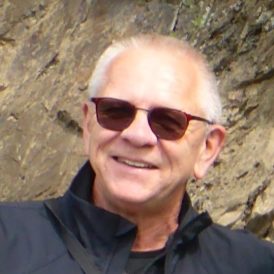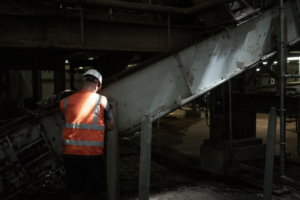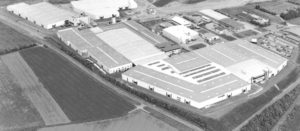
At the beginning of 1999, our then managing director approached me and said: "We're going on a business trip.“ But he didn't come out with what we were going to see. So we drove to Berlin and from there we took the A13 south. At some point we came to a makeshift exit where there was a sign saying "Baruth". Then we drove on for about 15 kilometres, to the right and left the pine trees of the Mark Brandenburg, very close tree to tree, in the villages there were partly only sandy roads without a road surface. Then we turned right, there were a few old industrial buildings, a little further on a sawmill, otherwise a 20-metre-wide sand track with very deep bumps led straight ahead. Finally we came to a place where on the left side there was a huge area with nothing but the finest yellow sand. And on the right side there was nothing but forest with the Marches pines. We stopped and I asked,
"What are we actually doing here?"
"Yes," said my manager, "where there is now the large free area of sand, a company is building a panel factory for MDF boards. They want to use the sawdust from the sawmill to make boards. And opposite where the trees are now, we have decided to build a new laminate plant." So that was the plan: to use synergy effects by delivering wood for the sawmill in front, the panel plant would process the sawdust into panels and we would coat and process them into laminate directly opposite.
CLASSEN had bought a site there in Baruth that was 1 kilometre x half a kilometre wide, or 50 hectares. "We are planning to run the first production here in 2001," my managing director opened to me. And there I was, looking at a huge area of forest! There were, of course, many questions in my head at first. How do you plan such a big project?
Then we went back and thought about it: What can we do better in Baruth than at the Kaisersesch site, where we had almost reached the end of our production and space capacities at that time. One thing quickly became clear to us: if we had so much space in Baruth, we wanted to plan the plant in such a way that we could bring the boards in on one side, coat them in a straight run, cut them to size and profile them, and store them on the other side as finished laminate in a high-bay warehouse.
When we got the first ground plan of the site, we started planning. We got plans of the existing machines in Kaisersesch, drew the machines in a certain scale on paper, cut them out and then lined them up. And that's when we came up with a plant length of 350 metres!

In Kaisersesch we had a production capacity of 18 to 20 million square metres of laminate flooring per year at that time. And of course we wanted to achieve more in Baruth. The fact that Baruth now produces 80 million square metres a year shows that we succeeded. At that time, we planned with three profiling lines plus all the associated infrastructure such as short-cycle presses. That was our first basic framework for a hall: 400 metres long and about 100 metres wide. We planned this complex on the site in such a way that we could expand the plant later if necessary. And that was to happen very quickly over the years.
When we started building, it turned out that the amount of sand in the Baruther Urstromtal valley was not as problematic as we had first feared. For a start, there is sand ten metres deep under the surface, no stones. Nevertheless, after appropriate static tests, the ground was load-bearing enough for the four-by-four-metre hall foundations per support. We planned the hall with as few internal supports as possible, so that it had a self-supporting steel construction with a span of 50 metres, which was also something special at the time.
In the middle of the construction phase, in the winter of 2000/2001, we had a really exceptionally cold winter with more than minus 20 degrees. And that was while we were already setting up the machines in the halls. We had to put cable reels in heated containers to warm them up, so that we could lay the cables at all. But everything worked out somehow, and we actually started up the first production lines as planned in 2001.
We soon realised: the factory was not enough! Our laminate was experiencing a huge boom. So in 2003 we mirrored the entire factory and doubled the capacity. So when plant 2 was up and running, I thought to myself: maybe things will be a bit quieter now. But I was wrong! It didn't take long before we started thinking about building our own board plant in Baruth. And on 6 August 2007 we pressed the first record there. And it went on and on until we were and still are the world's largest laminate plant at a single location.
"This can't all be true!"
I often looked at the factory in Baruth and thought, "This can't all be true!" Everything has become so big and it has been built incredibly quickly. From today's perspective, despite stress and small and large challenges, it was a task that was a lot of fun. I am proud of what we created there together as a team and of having been part of it myself.





4 Responses
Ein sehr schöner Blog-Beitrag! Es ist schön etwas über die Entstehungsgeschichte zu lesen – und das ziemlich kompakt.
Danke Hendrik! Bald kommt mehr!
Eine beachtliche Leistung und ein Werk was seines Gleichen in der Branche sucht.
Ich gratuliere der Classen Mannschaft zu dieser beachtlichen Leistung und freu mich auf den nächsten Besuch in Baruth.
Jederzeit Willkommen in Baruth!